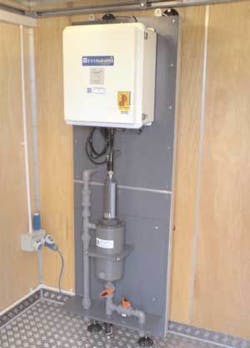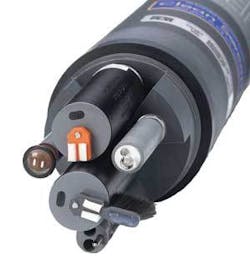Severn Trent Water Benefits from Intake Protection System
YSI HydroSAM intake protection systems give drinking water treatment plants advance notice of what’s coming down river. Historically, such systems have been large, complicated, labour-intensive affairs, but this new one is simple, compact and reliable, requiring a lot less maintenance.
Severn Trent Water was one of the first utility companies to try YSI’s new multiparameter intake protection system, the HydroSAM, testing it on the river Severn upstream of the Shelton Water Treatment Works (WTW).
Works manager Natalie Horton says, “The performance of the new water quality monitor has been absolutely brilliant... The main benefit for us has been the reduced requirement for calibration and maintenance”.
The multiparameter flow sensor unit is designed to replace older water quality monitoring systems that draw samples through a network of pipes which feed a series of in-line sensors.
Until now, these wall-mounted systems have been installed to monitor water quality upstream of river abstraction points, so plant managers are provided with data to inform water treatment decisions. Such systems, however, require a high level of maintenance and frequent calibration.
In contrast, the HydroSAM has been designed for minimum maintenance and long-term deployment. At it’s heart is a multiparameter probe known as a “sonde”, thousands of which are in use worldwide as in situ water quality loggers in both freshwater and marine applications.
Water quality monitoring sondes are often left in remote and difficult to access locations and, for this reason, YSI has developed sensor technology that’s able to take accurate readings without need for frequent site visits.
The sondes - undergoing evaluation for MCERTS accreditation by the UK Environment Agency for monitoring treated wastewater and receiving waters - also have been designed to be compact, which provides a further benefit to the HydroSAM. River water is pumped through a single sample chamber containing the sonde, so all of the sensors are exposed to the same sample.
The unit employed by Severn Trent Water monitors pH, temperature, conductivity, turbidity, dissolved oxygen and ammonia. It would be possible, though, to add sensors for chlorophyll and blue/green algae as well.
The sequence of events culminating in the company adopting the technology began with Horton becoming increasingly frustrated with problems and high maintenance requirements associated with traditional monitoring systems. She heard the Environment Agency deploys multiparameter sondes in rivers and approached YSI Hydrodata to discuss the possibility of their use for intake protection.
As a result, a sonde was installed directly in the river Severn upstream of the Shelton WTW near Shrewsbury, England, on a three-month trial.
Prior to the trial, the works manager admitted to a fair degree of skepticism over the sonde’s ability to cope with occasional high levels of fouling. After visiting the site, however, she said she was “delighted to discover that, as a result of the in-built sensor wiping mechanisms, the sensors were completely free from fouling and the readings correlated very closely with our own calibrated equipment”.
Following the success of the trial, Severn Trent Water ordered a full HydroSAM, which has been permanently installed 10 miles upstream of the water intake.
The system provides almost continuous monitoring data to the Shelton works and operators now have the ability to dial in to the unit from anywhere or visit the site and collect data with a portable computer. Alarm conditions have been set and the unit will issue alarms via the PCMS should those conditions arise.
Horton has since become Risk and Safety Manager for Water Supply at Severn Trent Water. Looking back over the HydroSAM trial, she says “It is vitally important for our water treatment works to be provided with advance knowledge of water quality and trends, so that we can manage the treatment process as effectively as possible. It is always our aim to maintain stability in the plant because unforeseen changes in the intake could necessitate a need for reduced flows to maintain water quality.
“For example”, she adds, “turbidity can range from 1 NTU to over 200 NTU, but this can be accommodated quite easily if we have an accurate and reliable intake protection system. However, the main benefit for us has been the reduced requirement for calibration and maintenance; site visits used to be necessary every week, but now a simple 6-weekly calibration check is all that is needed. We have been delighted with the HydroSAM - it was simple to install and operate, it has proved to be reliable, and it saves labour costs”.
Site visits that used to be necessary every week are now reduced to a simple 6-weekly calibration check.
Author’s Note:
Ian Thompson is regional director of YSI Hydrodata, a UK subsidiary of YSI Inc. Founded in 1948, employee-owned YSI is a market leader in sensor technology for water quality, level and flow instrumentation, offering real-time data collection systems for both marine and freshwater applications. Contact: +44 (0)1462 673581, [email protected] or www.ysihydrodata.com



